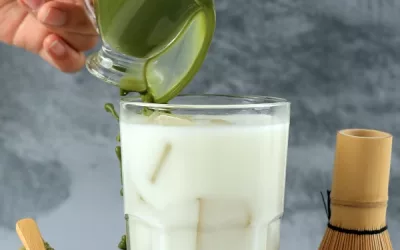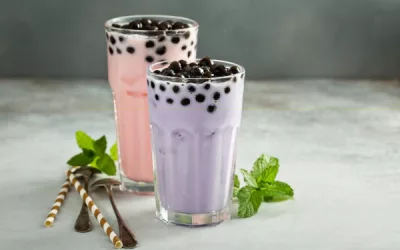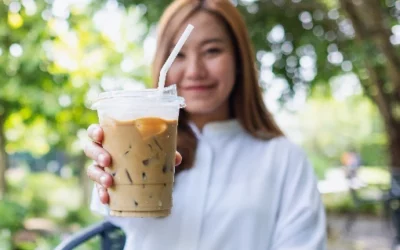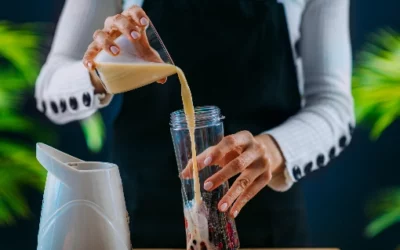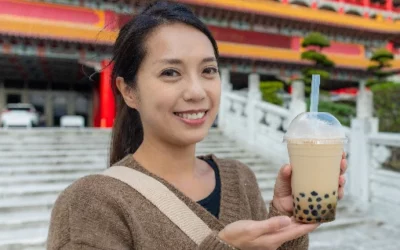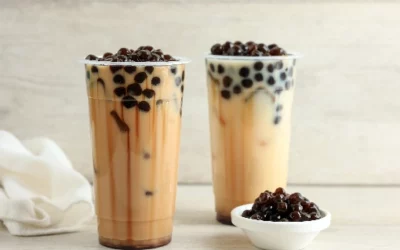Have you ever savoured the unique sweetness of taro boba? This delightful drink has captured the hearts of bubble tea lovers around the world, bringing a burst of flavour and colour to the classic beverage. Understanding taro boba is key for anyone looking to expand their bubble tea palate. From its intriguing origins to its potential health benefits, this article will guide you through everything you need to know about taro boba, ensuring your next sip is both enjoyable and informed.
Table of Content
What is taro boba?
Taro boba is a delightful variation of bubble tea that features taro root as its primary flavour component. Bubble tea, a beloved beverage originating from Taiwan, generally combines tea, milk, and chewy tapioca pearls. When taro root is added to the mix, it creates a distinctive flavour profile that sets it apart from other bubble tea flavours.
Taro root, a starchy tuber commonly used in Asian cuisines, adds a slightly sweet and nutty taste to the drink. The taro flavour is often complemented by creamy milk or milk alternatives, making it a rich and satisfying treat. Taro bubble tea also stands out because of its unique purple hue, which comes from the natural colour of the taro root.
The cultural significance of taro in bubble tea is rooted in its history and popularity in Taiwan and other Asian countries. Taro has been a staple ingredient in many traditional dishes and desserts, and its inclusion in bubble tea highlights its versatility. Compared to other bubble tea flavours like classic milk tea or fruity options, taro boba offers a more complex and intriguing taste experience.
What are the key ingredients in taro boba?
Taro boba is known for its creamy texture and distinctive flavour, which comes from a combination of key ingredients. These ingredients work together to create the unique taste and appearance of taro bubble tea.
- Taro Root: The star ingredient, taro root, provides the characteristic flavour and colour. It can be used in various forms, such as fresh, powdered, or as a flavouring syrup.
- Tapioca Pearls: These chewy, black pearls add texture and fun to the drink. Made from tapioca starch, they are cooked and then soaked in a sweet syrup to enhance their flavour.
- Milk or Milk Alternatives: Traditional bubble tea uses dairy milk, but many places offer options like almond milk, soy milk, or coconut milk for those who prefer non-dairy alternatives.
- Sugar or Sweetener: To balance the flavours, a sweetener is often added. This can be simple syrup, honey, or even a flavoured syrup.
- Tea or Water: While some versions use a tea base like black or green tea, others might simply use water, especially if the focus is on the taro flavour.
Together, these ingredients create the rich, creamy, and slightly sweet beverage that taro boba fans love.
How did taro boba originate?
The origin of taro boba can be traced back to the early days of bubble tea in Taiwan. Bubble tea itself was invented in the 1980s, combining tea, milk, and tapioca pearls to create a refreshing and chewy drink.
Taro root found its way into bubble tea recipes as people began experimenting with different flavours to add variety and appeal.
- 1980s Taiwan: Bubble tea was created by mixing tea, milk, and tapioca pearls, and quickly gained popularity due to its unique texture and flavour.
- Experimentation with Flavours: As bubble tea grew in popularity, vendors started experimenting with various flavours, including fruit, chocolate, and local ingredients like taro.
- Cultural Significance of Taro: Taro has long been a staple ingredient in many Asian cuisines and desserts. Its familiar taste and versatility made it a natural choice for a bubble tea flavour.
- Global Spread: As bubble tea spread to other countries, the inclusion of taro in the flavour line-up helped to introduce this traditional ingredient to new audiences.
The combination of bubble tea’s fun and interactive nature with taro’s unique flavour has made taro boba a favourite among bubble tea enthusiasts worldwide.
What makes taro unique compared to other bubble tea flavours?
Taro boba stands out from other bubble tea flavours for several reasons. Its distinctive taste, vibrant colour, and cultural significance all contribute to its unique appeal.
- Distinctive Flavour: Taro has a naturally sweet and nutty taste that is different from the more common flavours in bubble tea, such as classic milk tea or fruit-based options.
- Vibrant Colour: The purple hue of taro bubble tea is eye-catching and adds a visual appeal that sets it apart from other flavours.
- Creamy Texture: The starchy nature of taro root contributes to a creamy, smooth texture that enhances the overall drinking experience.
- Nutritional Benefits: Taro is a good source of fibre, vitamins, and minerals, making it a more nutritious option compared to some other flavours.
- Cultural Connection: For many, taro boba is a nostalgic flavour that connects them to their cultural heritage and traditional Asian desserts.
These factors make taro boba a unique and appealing choice for those looking to try something different in their bubble tea adventures.
In the early 20th century, taro was a crucial food source in many Asian countries. During the Japanese occupation of Taiwan from 1895 to 1945, local farmers were encouraged to cultivate taro due to its high yield and nutritional value.
Despite hardships, taro remained a staple in Taiwanese cuisine, symbolising resilience and cultural pride. This historical significance adds another layer of appreciation for taro boba, connecting modern-day enthusiasts with a rich past.
I remember the first time I tried taro boba. I was hesitant, unsure about the purple colour and unfamiliar flavour. But the first sip changed everything. The creamy, slightly sweet taste was unlike anything I had tried before. It became my go-to drink, sparking my love for bubble tea.
Now, every time I enjoy taro boba, it reminds me of that first adventurous sip and the joy of discovering new flavours.
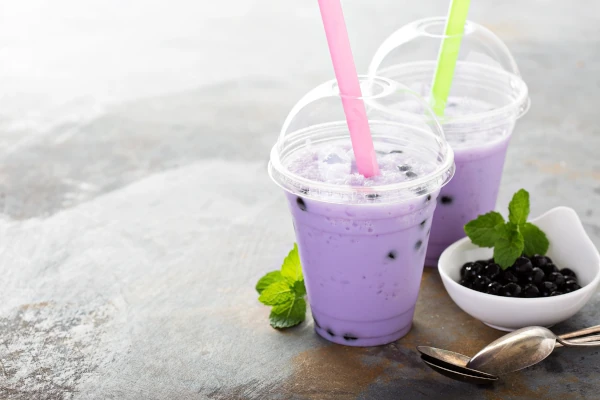
How is taro boba made?
Making taro boba at home is a delightful experience. You’ll transform simple ingredients into a delicious and visually captivating drink. Let’s break down the process to ensure you can easily follow along. We’ll go over the key ingredients and the preparation steps.
For those new to taro boba, it’s a bubble tea variant featuring taro root, which gives it a distinct purple hue and a unique flavour profile. Taro boba combines the creamy texture of taro milk tea with the chewy delight of tapioca pearls. Here’s how you can make it from scratch.
To understand the preparation, refer to the table below. It lists the ingredients, their quantities, and step-by-step instructions. Each row represents either an ingredient or a preparation step, ensuring clarity. Follow along, and soon you’ll be sipping your homemade taro boba.
| Item | Amount | Notes on Preparation |
|---|---|---|
| Taro Root | 1 medium-sized | Peel, cube, and boil until tender |
| Tapioca Pearls | 1/2 cup | Cook according to package instructions |
| Water | 4 cups | For boiling taro and tapioca pearls |
| Milk | 1 cup | Whole milk or any milk alternative |
| Sugar | 2 tablespoons | Adjust sweetness to taste |
| Ice Cubes | 1 cup | For serving |
| Optional: Tea | 1 tea bag | Black or green tea for extra flavour |
| Blender | 1 | For combining taro and milk |
| Saucepan | 1 | For cooking tapioca pearls |
| Large Bowl | 1 | For mixing ingredients |
Preparation steps:
- Prepare the taro root:
- Peel, cube, and boil the taro root in water until tender.
- Mash it into a smooth paste.
- Cook the tapioca pearls:
- Boil the pearls as per the package instructions.
- Drain and rinse them in cold water.
- Blend the taro paste:
- Blend the taro paste with milk and sugar until smooth.
- Prepare the tea (optional):
- Brew the tea and let it cool.
- Combine ingredients:
- Mix the taro blend with tea (if using), ice cubes, and cooked tapioca pearls.
- Serve:
- Pour into a glass and enjoy your homemade taro boba!
What are the key ingredients in taro boba?
Taro boba relies on a few specific ingredients that contribute to its distinctive taste and texture. Let’s dive into these essential elements:
- Taro Root: This starchy tuber gives the drink its unique flavour and purple colour. It has a creamy, slightly sweet taste.
- Tapioca Pearls: These chewy balls add a fun texture to the beverage.
- Milk: Use whole milk for richness, or any milk alternative like almond or oat milk.
- Sugar: Enhances the sweetness of the taro and balances the flavours.
- Tea (Optional): Adds depth to the drink, complementing the taro’s sweetness.
These ingredients create the foundation of taro boba. Let’s explore their attributes and how they contribute to the final product.
- Versatility of Taro Root: You can use fresh taro root or taro powder. Fresh taro offers a more authentic taste, while taro powder is convenient.
- Tapioca Pearls’ Chewiness: These pearls come in different sizes and colours. The black ones are the most common.
- Milk Variations: You can experiment with different types of milk to suit dietary preferences.
- Adjustable Sweetness: You can tailor the level of sweetness by adjusting the sugar content.
- Tea Options: Black tea adds robustness, while green tea offers a lighter, refreshing touch.
Understanding these components helps you customise your taro boba to your liking.
Can you customise taro boba?
Absolutely! Customising taro boba is part of the fun. You can tweak various aspects to suit your taste preferences. Here are some ideas for personalising your taro boba:
- Flavouring: Add vanilla or almond extract for an extra layer of flavour.
- Sweetness: Use honey, agave, or even stevia as alternative sweeteners.
- Tea Choices: Experiment with different teas like jasmine or matcha.
- Toppings: Besides tapioca pearls, try adding coconut jelly, grass jelly, or popping boba.
- Temperature: Enjoy it hot or cold, depending on your mood or the weather.
These customisations make your taro boba experience uniquely yours.
- Different extracts: Enhance the aroma and taste with vanilla or almond.
- Sweeteners: Honey, agave, and stevia offer healthier or different sweetness profiles.
- Tea varieties: Jasmine and matcha tea bring unique flavours and health benefits.
- Alternative toppings: Coconut jelly or popping boba add varied textures.
- Serving temperature: Hot taro boba is comforting in winter, while cold is refreshing in summer.
Customising gives you the freedom to explore and enjoy taro boba in various ways.
In the 1980s, bubble tea originated in Taiwan. At this time, the idea of mixing tea with milk and tapioca pearls was novel. It created a refreshing and flavourful drink for people of all ages. Initially, traditional flavours like black and green tea were popular.
However, as bubble tea spread globally, inventive variations emerged, including the beloved taro boba.
What does taro boba taste like?
Alright, bubble tea aficionados, let’s dive into the tantalising world of taro boba. Picture a swirl of purple goodness, bringing together sweetness, a nutty hint, and a creamy texture that might just give you a hug in drink form.
Think of it as the lovechild of a cupcake, a nut, and a scoop of smooth ice cream. Taro boba’s taste is like having a sweet potato that decided to up its game and take a bath in sugar and milk.
There’s also an interesting play of flavours; it can be both familiar and exotic at the same time. It’s sugary but not in an overwhelming way—just enough to keep your taste buds dancing. When you sip taro boba, you’re getting a multi-layered experience.
You’ve got the taro root itself, often used in Southeast Asian cuisines, bringing in its naturally sweet and nutty undertones. Combine that with the creaminess of milk and the essential chewy tapioca pearls, and you have a concoction of textures and flavours that keep you coming back for more.
How does the taste of taro boba compare to traditional bubble tea?
If you’re wondering how sipping taro boba measures up to slurping down your run-of-the-mill bubble tea, here’s the lowdown. Traditional bubble tea, often brewed from black or green tea and sweetened with various syrups or fruit flavours, can be a bit all over the place taste-wise.
You can choose from fruity explosions like mango or strawberry or classic flavours like matcha or milk tea.
- Taro boba, however, usually brings a much more subtle yet sweet flavour.
- Traditional bubble tea often has a more robust or even slightly bitter undertone from the tea itself.
- Taro’s creaminess cuts through to provide a smooth, velvety sip every time.
- Traditional bubble tea can range from tangy to earthy to sugary or milky, sometimes all at once.
- Taro boba is like the sophisticated cousin who likes to keep things mellow yet indulgent.
So, if you love the variety offered by traditional bubble tea flavours, taro boba gives you a creamy escape that’s consistent and luxuriously rich.
What factors influence the taste of taro boba?
You might think it’s just taro and milk doing the job, but no, multiple factors influence the flavour of your precious purple potion. First off, quality matters. Fresh taro vs. taro powder can make a world of difference.
Fresh taro delivers a more authentic, earthy flavour, whereas taro powder usually contains sugar and artificial flavours.
- The quality of the milk or milk substitute used.
- The sweeteners: from condensed milk to honey to sugar syrup.
- The type of tea base: black tea, green tea, or no tea at all.
- Add-ins like coconut, almond, or other flavourings can change your experience.
- Even the temperature: hot taro boba vs. iced taro boba can alter your taste perception quite a bit.
These elements can swing the flavour from “meh” to “give me more!” faster than you can say ‘tapioca pearls’.
Are there variations in taste based on preparation methods?
You bet there are! The method of preparing taro boba is like the backstage crew of a theatre production—hidden but crucial. Let’s talk about how different methods can alter the taste significantly.
- Traditional boiling of fresh taro and blending it gives you a richer, denser and more natural taste.
- Using taro powder offers convenience but can be more artificial and sweeter.
- Some places use frozen taro, which could make the drink creamier.
- Adding additional flavours, like coconut or vanilla, can provide a new twist.
- Hot vs. iced: Hot taro boba tends to amplify the creaminess, whereas iced can make it more refreshing but might mute some flavours.
If you’re adventurous and make it at home, your kitchen skills and ingredient choices can create endless variations.
So, next time you sip on that purple delight, remember you’re enjoying a drink with a complex ensemble of flavours and textures, lovingly curated to give you that perfect bubble tea experience.
And hey, thank the brilliant minds behind the trends and preparation methods that make your sips a joy ride.
Oh, and speaking of brilliant minds, let’s talk about Sir Joseph Banks. Ever heard of him? He was an English naturalist who, in the late 18th century, joined Captain James Cook on his first great voyage. Imagine the curiosity that led someone to brave the high seas to study plants worldwide.
However, he collected plant specimens and introduced new types of tropical plants to Europe. Among those specimens were various tubers, potentially even the precursors to what we’d now recognise as taro.
So every time you enjoy a taro-based treat, think about the explorers and botanists whose curiosity shaped our delicious world today. Thanks, Joe!
How can one make taro boba healthier?
Nutritionally speaking, taro root is packed with goodies like fibre, vitamin E, magnesium, and potassium. These elements bolster digestive health, support your heart, and keep your muscles happy. The fibre in taro root can also help with maintaining a balanced gut, which is good news for those chasing a healthy lifestyle.
But don’t start downing gallons of taro boba just yet. Many taro boba drinks come with a hefty dose of sugar and calories from the sweeteners and tapioca pearls. It’s the kind of sneaky treat that makes your taste buds cheer but might give your waistline a side-eye. Moderation is key here, just like with any indulgence.
Look, if you want to enjoy your taro boba without regrets, some tweaks can make your drink a healthier option. It’s all about making smart choices.
Opt for alternative sweeteners
Instead of the usual sugar overload, consider asking for alternative sweeteners. Here’s how to lighten your taro boba:
- Switch sugar for honey or agave syrup—natural and less processed.
- Try stevia, the plant-based sweetener that won’t spike your blood sugar.
- Half the sweetness level; most bubble tea shops let you control sweetness.
- Choose non-dairy milk options like almond or soy to cut down on calories.
- Go sugar-free and add fresh fruit for a natural sweet touch.
This way, you get your sweet fix without the sugar rush (and crash).
Cut down on toppings
Toppings can be a calorie trap in disguise. That’s right, those chewy pearls might be doing more harm than good.
- Limit tapioca pearls to a smaller portion. They’re yummy but calorie-dense.
- Opt for aloe vera cubes or chia seeds for added texture and fewer calories.
- Swap out jelly cubes for fresh fruit pieces.
- Skip the condensed milk topping, just enjoy the taro goodness.
- Experiment with more tea and fewer toppings for a refreshing twist.
These small changes can make your taro boba both enjoyable and friendlier on your health.
Is taro boba a healthy choice compared to other beverages?
When pitted against other drinks, taro boba can hold its own, but context is everything.
Let’s see how taro boba stacks up:
- Compared to regular sodas, taro boba usually contains more nutrients and less artificial junk.
- Versus fruit juice, taro boba has added fibre from the root, but often more sugar if sweetened.
- Against coffee shop frappes, taro boba might have fewer hidden sugars and fats.
- Juice smoothies might have more vitamins but sometimes just as much sugar.
- Water and unsweetened tea are still kings in the health department, but hey, they aren’t as fun!
So, taro boba isn’t a health devil, but don’t mistake it for a health saint either.
Now, on a brighter note, let’s travel back to ancient history for a moment. Taro root has been a staple in many cultures, such as in Polynesia, where it has been grown for over 1,000 years.
They might have initially used it as a food staple to survive, but now it’s grown into this cross-continental trend of taro boba! Imagine the Polynesians’ surprise if they could see their humble root getting whipped into frothy, sugary drinks all around the globe.
It’s a testament to how food transcends through time and geography, evolving in the most unexpected ways.
Where can you find the best taro boba?
If you’re a bubble tea devotee searching for the crème de la crème of taro boba, you’re in luck. Tracking down the finest taro boba concoction can be akin to a treasure hunt. But worry not!
Let’s dive into where you can find these purple delights, from hidden local gems to the big leagues of bubble tea chains.
What should you look for in a good taro boba?
When you’re on the hunt for top-tier taro boba, you want to be Sherlock Holmes, not Inspector Clouseau. Here’s the lowdown:
- Authenticity: Real taro taste, not some fakey, artificial flavour.
- Texture: Chewy tapioca pearls—think gummy bear, not rubber tire.
- Creaminess: The right balance of milk and taro. Too watery or too thick? Nah mate.
- Sweetness: Not too sweet to send you to the dentist, just enough to make your taste buds dance.
- Appearance: Vibrant lavender hue. Dull and drab? No, thank you.
A first-class taro boba stands out in its authenticity. Imagine biting into soft taro flesh rather than a chemically flavoured liquid. The texture of pearls should be bouncy yet tender—if you wanted to chew on rubber, you’d play with your dog’s toys.
And let’s be real, milky consistency should cradle the taro flavour gracefully, avoiding both extremes of being a thick paste or a watered-down soup. Finally, the drink’s appearance should be Instagram-worthy with its delightful purple shade, inviting you to snap that perfect pic before your first sip.
How do local shops compare to larger chains?
Time to settle the age-old debate—David vs Goliath in the bubble tea world. Here’s what to consider:
- Customisation: Local shops often let you tweak your order to perfection.
- Freshness: Smaller joints typically serve fresher ingredients.
- Consistency: Chains usually guarantee the same quality wherever you go.
- Price: Chain stores might have friendlier prices due to bulk purchasing.
- Atmosphere: Local spots often have a charming vibe and community feel.
Local shops are like your favourite indie bands. They offer a unique charm, often taking pride in customising each cup to suit your cravings. Plus, local shops are likely to use fresher ingredients, ensuring each sip bursts with flavour.
On the flip side, chains like Gong Cha or Koi Cafe offer consistency—you know what you’re getting, no matter the location. Prices at larger chains can be gentler on your wallet given their bulk buying power.
Not forgetting the quirky, cosy atmosphere of local spots where the barista might double up as a friendly guide to the neighbouring area.
Did you know bubble tea first bubbled up in the streets of Taiwan in the 1980s? Lin Hsiu Hui, a teahouse owner, stumbled upon this delightful mix while experimenting with tea during a staff meeting.
She added fen yuan (a type of sweet Taiwanese dessert), and—bada bing bada boom—bubble tea as we know it today was born. From there, the trend spread faster than a cat video on social media, eventually evolving into our beloved taro boba. Cheers to happy accidents!
Can you customize your taro boba?
Absolutely, you can customise your taro boba to suit your wildest bubble tea fantasies. Taro boba isn’t some rigid, one-size-fits-all beverage. Just think of it as a blank canvas that allows you to experiment with different tweaks to create your dream drink.
From alternative milk options to custom sweetness levels and an array of delightful toppings, taro boba offers endless possibilities.
Mixing it up with different kinds of milk can change the creaminess of your boba, adjusting the sweetness can create a drink that’s just right for your taste buds, and choosing from a range of toppings can make each sip a surprise.
It’s like being the barista in your very own bubble tea lab. So, let’s break this down and get your taste buds ready for a wild ride!
What are the best milk alternatives for taro boba?
Choosing the right milk can make a huge difference in your taro boba experience. Don’t settle for basic cow’s milk if you’re feeling adventurous. Have fun with the variety of milk alternatives available to make your drink stand out.
- Almond Milk: Light and nutty, almond milk can add a subtle flavour that complements the sweet, earthy taste of taro.
- Oat Milk: Creamy and slightly sweet, oat milk pairs beautifully with the starchy richness of taro.
- Coconut Milk: For a tropical twist, coconut milk adds a rich and aromatic depth to taro boba.
- Soy Milk: Smooth and adaptable, soy milk is perfect if you’re looking for a plant-based alternative with a mild taste.
- Cashew Milk: Extra creamy, cashew milk can enhance the velvety texture of your taro boba.
Selecting the right milk isn’t just about taste—each type contributes to the drink’s texture and overall experience. Whether you’re lactose intolerant, vegan, or just curious, there’s an option for everyone.
How can you adjust the sweetness of your drink?
Sweetness is a deal-breaker for many when it comes to bubble tea. One sip too sweet or too bland, and you might be throwing that cup away. Fortunately, your taro boba is fully customisable in the sweetness department.
- Full Sugar: Ideal for those with a serious sweet tooth. This is where your drink becomes borderline dessert.
- 75% Sugar: A tad less sweet but still quite indulgent. Best for those who like their sweets but not overwhelmingly so.
- 50% Sugar: For a balanced approach. Enough sweetness to enjoy, but without the sugar rush.
- 25% Sugar: Just a hint of sugar to accentuate the taro’s natural sweetness.
- No Sugar: If you’re all about that raw, earthy taro goodness, this is the option for you.
Varying the sugar levels can really elevate your taro boba to match your taste preferences. It’s almost like being a kid in a candy shop—aim to find that perfect balance between flavour and sweetness.
What toppings pair well with taro boba?
Toppings are where things get really fun. The texture, flavour, and overall sensation of your taro boba can be tweaked with the right additions. Here are some top contenders that can match the unique flavour of taro.
- Classic Tapioca Pearls: The chewy, iconic boba experience.
- Pudding: Silky smooth, pudding adds a custard-like texture that’s utterly delectable.
- Grass Jelly: A herbal and slightly bitter contrast that cuts through the sweetness.
- Red Bean: Adds a sweet and starchy element that pairs perfectly with taro.
- Aloe Vera: Light and refreshing, aloe vera chunks offer a clean counterpoint to the rich taro flavour.
Exploring various toppings can take your taro boba experience to another level. It’s not just about the flavour anymore; it’s about creating a medley of tastes and textures that dance on your palate.
During the 1980s, bubble tea was invented in Taiwan at a small teahouse called Chun Shui Tang. The owner, Liu Han-Chieh, decided to introduce cold Chinese tea to the locals. The quirky addition of tapioca pearls was a stroke of genius from his product development manager.
One day, she decided to pour her sweetened tapioca pudding into her glass of iced tea during a meeting. The unexpected combination received rave reviews from her colleagues, and just like that, bubble tea was born.
This little experiment turned into a global phenomenon, and here we are today, customising taro boba to our heart’s content!
How to make taro boba at home?
Alright, let’s get down to brass tacks. You’re here because you want to master the art of making taro boba at home. This is understandable; the joy of a well-crafted bubble tea is unparalleled.
Think of the sweet, nutty flavour combined with those iconic chewy pearls. Mouth-watering, right? So, let’s dive into the nitty-gritty.
Making taro boba at home is a game-changer. Not only do you get to enjoy this delightful beverage on the reg, but you also get full control over the ingredients. There’s no need to depend on your favourite bubble tea spot being open.
Plus, you can tweak the recipe to your heart’s content.
What ingredients are essential for homemade taro boba?
Let’s start with the basics. Here’s a list of must-haves for whipping up some top-notch taro boba:
- Taro Powder or Fresh Taro: This is your flavour base. Fresh taro will give a creamier texture.
- Tapioca Pearls: The chewy, boba goodness at the bottom of your cup.
- Milk: You can opt for dairy or go for a plant-based option – coconut milk is particularly fab.
- Sugar: To sweeten the deal. Brown sugar can give a richer flavour.
- Water: Obvious, but it’s the lifeblood of many great beverages.
- Ice: To keep it refreshingly cold!
It’s essential to source quality ingredients. Fresh taro has the upper hand on the texture front, while good tapioca pearls retain that perfect chewiness.
Are there any common mistakes to avoid when making taro boba?
Of course, not everything’s always rainbows and butterflies. Plenty can go wrong. Let’s save you the heartbreak.
- Overcooking Tapioca Pearls: Avoid turning your boba into a gelatinous blob. Stick to the cooking times.
- Skipping the Soak: Your pearls need to soak up sweet syrup or they’ll taste bland.
- Lumpy Taro: If using taro powder, mix it properly to avoid those unwelcome lumps.
- Wrong Consistency: You don’t want watery or overly thick bubble tea. Find that sweet spot.
- Ignoring Freshness: Rank ingredients = Rank tea. Fresh is always better.
Avoiding these blunders will keep your bubble tea aspirations firmly on track!
How can you ensure your taro boba has the right texture?
Texture is King in bubble tea. Here’s the cheat sheet for that perfect mouthfeel:
- Proper Cooking Time for Pearls: Follow the instructions on your tapioca pearls package; they know their stuff.
- Consistency is Key: Aim for a smooth, creamy consistency for your taro base. Whether it’s powder or fresh taro, blend it well.
- Sweet Soak Session: Boil the pearls in syrup post-cooking. Don’t skip this or you’ll regret it.
- Right Chill: Serve with ice. Lukewarm taro boba is a sad tale.
Ensuring the right texture makes all the difference between a so-so drink and a boba masterpiece.
Way back in the 1980s, bubble tea – boba’s classy ancestor – was born in Taiwan. It became an international sensation when it made its way across borders, thanks to folk going bonkers over its chewy pearls and sweet ambrosial mixtures.
Even the English Queen around that time, Queen Elizabeth II, was once gifted bubble tea during one of her trips to Asia. Word has it she found it quite the intriguing beverage. So, by perfecting your taro boba, you’re not just making a drink; you’re participating in a global cultural phenomenon – one that even caught royal attention!
Cheers to that!
What are some popular variations of taro boba?
Taro boba isn’t just your run-of-the-mill beverage, oh no. It’s a chameleon in the world of bubble tea, able to adapt to various flavours and forms to suit the wildest of taste buds. Whether you’re a classic milk tea aficionado or someone who likes their drink on the icy side, there’s a taro boba variation for everyone.
The versatility of taro boba is nothing short of impressive. You see, taro, with its sweet, nutty flavour and vibrant purple hue, serves as a perfect canvas for many delightful combinations.
The popularity of these variations is driven by their ability to cater to diverse palates and dietary needs, from gluten-free options to ones loaded with all the creamy decadence your heart desires.
What are the most common variations of taro boba?
When it comes to taro boba, the list of common variations is practically endless. Here are a few to get you started:
- Taro Milk Tea: The classic. Creamy and rich with that signature taro flavour, perfect for purists.
- Taro Slush: A blended iced delight, perfect for those scorching days when you need a frosty pick-me-up.
- Taro Coconut Boba: For anyone dreaming of a tropical twist, this pairs taro with coconut milk.
- Taro Matcha Boba: When you’re feeling both earthy and sweet, this blend combines taro with the robust flavour of matcha.
- Taro Smoothie: Amp up the health factor with a taro smoothie, often blended with fruits like banana or berries.
Whether you’re after something indulgent or refreshing, these taro boba variations will keep your taste buds entertained.
How do these variations change the overall experience?
The variations in taro boba are more than just cosmetic changes. They genuinely transform the entire drinking experience, making each sip feel like a new adventure:
- Taro Milk Tea delivers a smooth, creamy treat that feels like a hug in a cup.
- Taro Slush offers a cooling, icy texture that can refresh you on the hottest days.
- Taro Coconut Boba gives you a tropical vacation in a cup, mixing the nuttiness of taro with the creamy richness of coconut.
- Taro Matcha Boba balances the sweetness of taro with the slightly bitter, earthy taste of matcha.
- Taro Smoothies add a health kick, bringing a natural sweetness and creaminess from added fruits.
Each variation provides a different mouthfeel and flavour profile, ensuring that there’s always something exciting every time you decide to indulge in taro boba.
Are there seasonal variations of taro boba?
Yes, indeed! Seasonal variations of taro boba are a thing, because why not keep things fresh and exciting? Here’s how these limited-time options can spice up your bubble tea game:
- Winter Warmers: Enjoy a hot taro milk tea or a taro latte to fend off the winter chill.
- Summer Coolers: Opt for taro slushes or smoothies when the temperature soars.
- Festive Flavours: Think pumpkin spice taro boba for autumn or peppermint taro boba during Christmas.
These seasonal twists let taro boba fans experience their favourite drink in new and festive ways throughout the year. You can always look forward to what the next season might bring in the world of taro boba.
Once upon a time, in the 1980s in Taiwan, a teashop owner named Lin Hsiu Hui was attending a boring staff meeting. In an attempt to liven things up, she poured her tapioca dessert into her Assam tea, creating the first bubble tea.
This culinary accident sparked a global craze, evolving into the taro boba varieties we adore today. So, the next time you’re sipping on your taro bubble tea, remember that its origin was something as mundane as a staff meeting, turned extraordinary by a stroke of creative brilliance.
Conclusion
Reflecting on the delightful journey we’ve taken through the world of taro boba, it’s clear that this unique beverage offers more than just a tasty experience. From its deep-rooted cultural significance to the simple pleasure of crafting it at home, taro boba stands out as a beloved choice among bubble tea enthusiasts.
We explored its key ingredients, notably the nutritional benefits of taro root, which add an extra layer of appeal, especially for those conscious of their health.
Understanding how to prepare taro boba allows for personalisation, catering to individual tastes and preferences, while also emphasising the importance of quality ingredients. The sweet, nutty flavour combined with various milk alternatives and adjustable sweetness levels ensures that there’s something for everyone.
Additionally, the exploration of local shops versus popular chains highlights the need for discerning taste when seeking out the best taro boba experience.
As I continue to sip on this delightful drink, I encourage you to experiment with your own variations and perhaps even create your own signature take on taro boba. The possibilities are endless, and each sip is a journey of flavour that reflects not just personal preferences, but also a rich cultural tapestry.
What unique twist will you bring to your next serving of taro boba? Remember, in the realm of bubble tea, creativity knows no bounds.
Resources
- Nutritional, phytochemical composition and potential health benefits of taro (Colocasia esculenta) leaves: A review
- Calories and sugars in boba milk tea: Implications for obesity risk in Asian Pacific Islanders
- Bubble tea consumption and its association with mental health symptoms
- Nutritional, Physicochemical, and Functional Properties of Five Taro (Colocasia esculenta) Cultivars
- 7 Surprising Benefits of Taro Root
- Tapioca Nutrition Facts and Health Benefits
- Characterization and stability of pitaya pearls from a nutritional perspective


